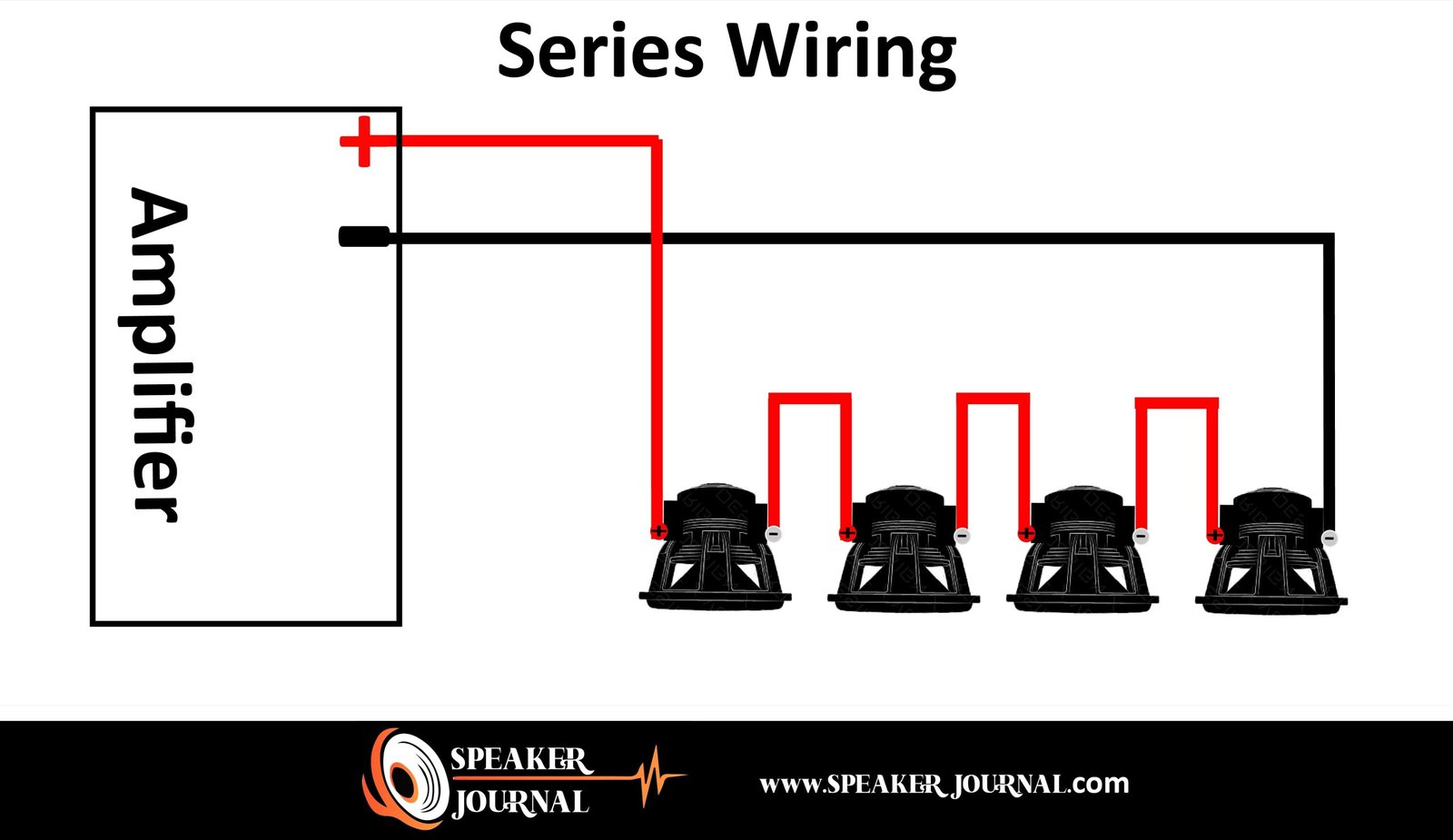A two or four channel amp can easily connect 4 speakers. The speaker impedance must be taken into account when deciding how much power to feed onto each channel.
There are two ways to connect 4 speakers:
Choose the one that best fits your speakers and amplifier. The speaker and amplifier have impedance and maximum levels that must not be exceeded to ensure safety.
When two or more components are connected in series, the impedance increases, and when they’re connected in parallel, it drops. When it comes to keeping an eye on the amplifier’s maximum and minimum impedance, you must stick to these parameters. Too much pressure, on the other hand, may be harmful or unpleasant.

To begin, figure out the maximum and minimal impedances of the amplifier you’ll be connecting up to the speakers.
The amplifier will be damaged if the load is lower than the minimum impedance. As a result, make sure that the load does not exceed either the maximum or minimum requirements.
On the amplifier’s label or in the user guide, you can discover the impedance of the device. The impedance of the speakers is also mentioned on their labels or in the instructions.
To do so, add the impedances of the two speakers you’ll be connecting to a single channel. If the amplifier is capable of handling the combined impedance, connect them in a series circuit.
For example, if you have 2 speakers with a combined resistance of 8 ohms. As you know, the total resistance is calculated by adding the resistances in the series. So the combined powers will be 8 ohms. If your amplifier can handle 8 ohms per channel, you may connect them in series.
If the speakers cannot be linked in series, the alternative option is to connect them parallel.
Divide the impedance of two speakers by their total resistance. If the answer is within limits, both speakers can be connected in parallel.
The amplifier will not connect if the impedance from both directions is out of limits.
Once you’ve decided which method of connecting you’re going to use, follow the steps below to connect them.

Find the positive and negative terminals on the amp.Positive terminals of one speaker are attached to negative terminals of the other in a series circuit.
Assume we connect two left speakers in series. Connect the positive terminal of the amplifier to the positive terminal of the first speaker.
The speaker wires from the negative terminal of the first speaker will then be connected to the positive terminal of the second speaker. Connect the wire from the second left speaker negative terminal to the amplifier’s left negative terminal.
Two speakers are connected in series to the left channel of the amplifier in this manner. Now follow the same procedure for connecting speakers to the right channel. Therefore, all four speakers will be connected in series with a 2 channel amplifier.
The series wiring method is our first method for connecting four speakers to a two-channel amp. Next, we will use parallel wiring.

In a parallel system, let’s connect 2 speakers to the left channel.
Attach the wire from the left channel’s negative terminal to the negative terminal of the first speaker. To connect the first speaker’s positive terminal to the positive terminal of the left channel, connect a cable between them. The corresponding connectors for the left and first speakers of the audio quality system will be connected in this way.
In the same way, connect the first speaker to the second speaker. As a result, two speakers can be connected to one channel in parallel.
Each speaker is connected to two amplifier channels in parallel. Parallel wiring is the second and last way to connect 4 speakers to a 2 channel amplifier.
Wiring two speakers to a single amplifier is feasible, yet it might harm your amplifier in various ways. It’s possible that you’re trying to run both the channels left and right on one speaker. It’s possible, but the technique varies from the amplifier to amplifier.
Because your 2 channel amplifier is most likely only 4 ohms stable, the THD would be very high. You’ll need to conduct some research to determine the maximum wattage of each speaker. The simplest way to connect all three of them together is to string the dual 4-ohm voice coils in series for a total impedance of 8 ohms. As a result, you have three speakers with an overall impedance of 8 ohms.
All you have to do is remember the impedance levels of speakers and divide the power equally between both channels, and you can connect four speakers to a two-channel amplifier in no time. 4 speakers can be connected in a variety of ways, including series and parallel.
A right pair of speakers is enough for most amplifiers. Similar to a passenger on a little motorbike: add another person, and the bike’s capacity requirements double, but most bikes can accommodate two passengers. However, if you connect more than two speakers to the same amplifier, it will soon overheat.
If you only need to power a single pair of speakers, a 2-channel amplifier will be the best option. If you want to keep your car’s rear speakers fill sound and retain front-to-rear fade adjustment, get a 4-channel amplifier — one channel for each speaker.
COPYRIGHT © 2021 · SPEAKERJOURNAL.COM, ALL RIGHTS RESERVED. WE ARE A PART OF THE AMAZON AFFILIATE PROGRAM. IF YOU BUY SOMETHING WITH OUR LINK WE GET A SMALL AMOUNT FROM AMAZON WITHOUT CHARGING YOU ANY ADDITIONAL AMOUNT. HOWEVER, WE DO UNBIASED REVIEWS. WE DISCUSS BOTH THE PROS AND CONS OF PRODUCTS SO THAT YOU CAN DECIDE WHETHER TO BUY OR NOT.
